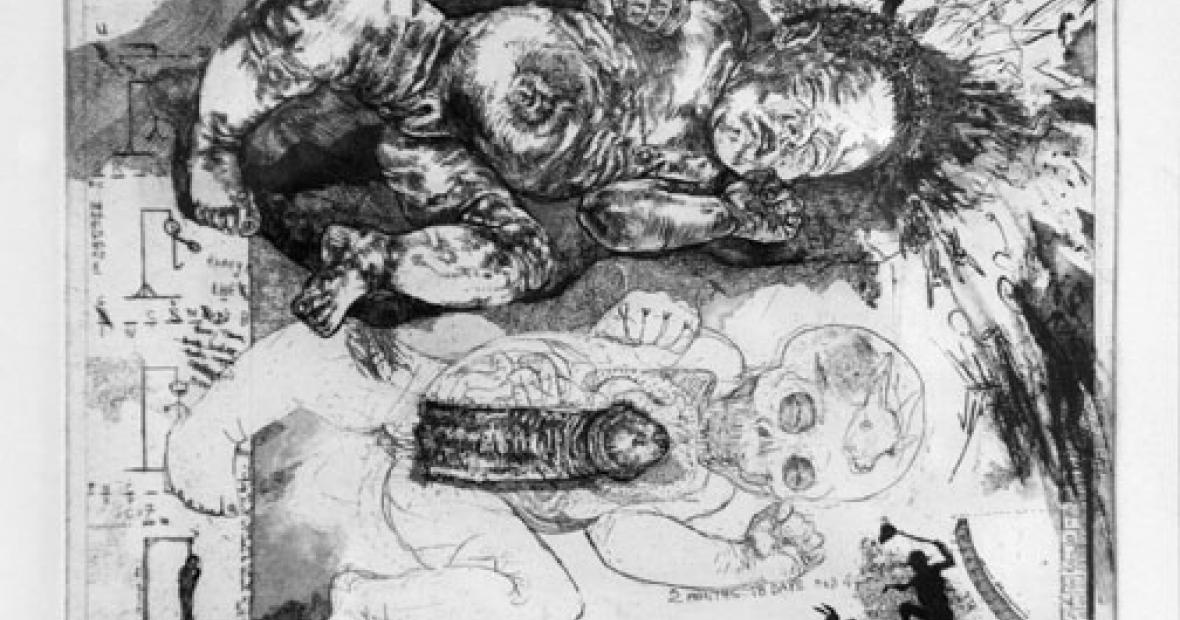Art Looking Life in the Eye
Art by Diane Victor
South African artist Diane Victor has traveled to the frozen fields of Iowa to complete drawings for her exhibition Of Fables and Folly, which opens here at the Faulconer on Friday, January 28. She is currently working on oversize drawings, made of smoke from candles, of South African prisoners—people whose lives are as ephemeral in the grand scheme of social power as the smoke that depicts them. These portraits are haunting, but bearable. Her prints on view in the upcoming show are much tougher to take. Victor takes an unflinching look at the injustices, violence, and travesties that lace post-apartheid South Africa. Blacks, whites, men, women and children circulate through her images as perpetrators and victims, underscoring that social dysfunction affects everyone. To understand Victor’s work is to confront realities we might prefer not to know about.
In presenting art to the public, we who curate are at an interesting intersection. If a subject has sexual, or violent, or religious content—or a combination of any of these—we consider more than carefully if we should show it, fretting about who may be upset or angered by the discomfort created. Granted, there are artists who use shock value to drive interest in work that probably isn’t worth a look. But there are also gifted creators with impeccable principles who know that a work of art can encapsulate a social truth better than words, or photographs. By passing reality through the creative process, a distillation occurs and we get at the kernel of the problem, undistracted by the issues of specificity over which we might argue. Think of the great novels, undergirded by historical realities but invented by their authors. Through them we encounter worlds we might never choose to see. Victor does the same.
So why do we shy away? Anyone who has passed through the grand galleries of the great art museums of the (particularly) western world has studied, admired, considered paintings with titles such as “The Rape of the Sabine Women,” “Death of Sardanapalus,” “Massacre of the Innocents,” in other words paintings about rape, death, and disaster. Religious art abounds with gruesome martyrdoms, images of sacrifice, and death at the hands of oppressors. A tour through Italy is punctuated with seemingly hundreds of Saint Sebastians pierced again and again by quivers full of arrows. We accept these horrific images without pause. Violence, sex and death are part of our common visual language.
But bring it into the present, in the hands of a master draftswoman like Diane Victor, and we grow queasy. It is a case of NIMBY in art—don’t go looking in my back yard for the senseless, the abusive, and the shocking. Don’t tell me that these things are happening in South Africa; apartheid is over and life should be better, right? Like Hogarth in the 18th century, Goya in the 19th, or Kathe Kollwitz in the 20th, Victor challenges us to face up to what’s rotten in the heart of civilization, and in doing so, to strengthen our resolve to do better. To do so, she reaches back into our past and calls on Greek mythology, and earlier masters (you can’t avoid Goya in her prints) to fortify her images. Her subjects come racing out of the past but their power comes from the present. Her technical abilities in printmaking and drawing are astonishing, and certainly worth a look purely for technique, but it’s tough to get past her subjects--which is as it should be.
I hope you’ll visit Victor’s exhibition, on view until April 17, 2011. She brings bravery to art, and calls to us to be as courageous.

